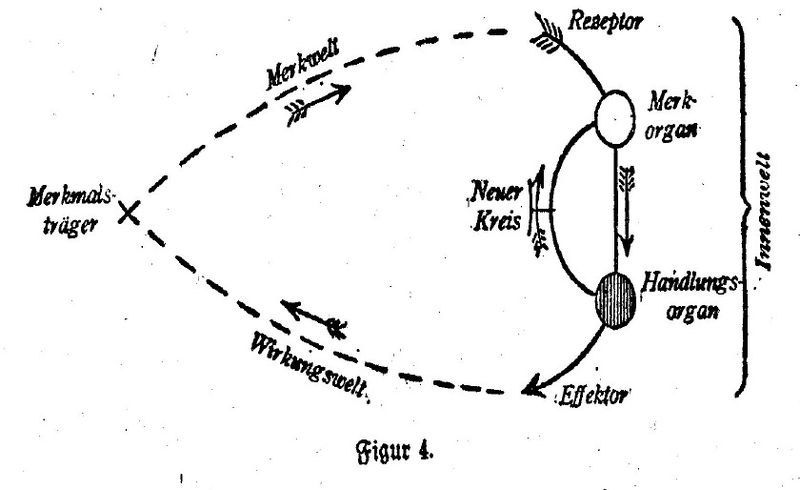meta-expression
semiosis
Words in their primary or immediate Signification, stand for nothing, but the Ideas in the Mind of him that uses them. John Locke, 1689 (emphasis added).
Language does not require words; physical gestures, for instance, constitute body-language. Any signs when used in any way to communicate, and especially when they are consistently organized into a whole, is potentially a language; and anything that a BEING recognizes, to that BEING through that recognition, is a SIGN of that which is recognized. Languages evolve organically and pragmatically. The meaning of words, for instance, branches through their daily use.
To more readily be able to discuss signs, and semiosis, Kant used the greek word 'noumenon' to refer to their underlying actualtity, to what he called the 'thing-in-itself'. Any entity, inanimate or animate, is a NOUMENON that can be recognized.
NOUMENA may function as signs of themselves — as being rocks, or holes, or hands, etc., or as qualities that they are associated with — food, danger, green, etc. They may also signify things distinct from themselves — a woman may signify a mother; a sound may signify "Mum!", a river, or a phoneme; marks may signify words, or symbols like pi, or a drawing or photograph of a pie or a pipe.
While EXPRESSION is individual and shared, language is social and specific; a mutually recognized system of EXPRESSION used to convey information. Both refer to signs recognized through the process of BIOSEMIOSIS.
BEINGS learn fluency of EXPRESSION and language through their ONTOGENY, from individuation at 'conception' to maturation and death. Our words naturally refer to our experience and understanding, but defining words such as 'intelligence', 'language', 'feeling', and 'perception' exclusively in this way hobbles their use, and through their broadcasting drills an anthropocentrism into everyday thought and conversation.
As classically defined, an EXPRESSION is anything that might be understood, and therefore refers to any aspect of a NOUMENON, static or dynamic, that might be perceived as having significance, whether or not it is..
A language that contextualizes or defines another is a metalanguage. Similarly an EXPRESSION that contextualize or defines another may then be referred to as a meta-EXPRESSION. Meta-EXPRESSION is the semantic process of BIOSEMIOSIS illustrated in the diagram below.
biosemiosis
BIOSEMIOSIS is the RECOGNITION by a BEING of something present as being the same, or similar to, something perceived before; achieved by comparing a present experience with experiences previously EMBODIED both by itself and through inheritance. ENDOSEMIOSIS is then the internal EXPRESSION of RECOGNITION and EXOSEMIOSIS its EXPRESSION externally.

A — The quality and insistency of the spacio-temporal presence of external noumena.
EXPERIENCE — Exosemiotic reaction. Data generated by sensory receptors in response to input A.
B, C, D & I — Endosemiosis, for instance, through endocrine, immune, and nervous systems.
E — Exosemiotic EXPRESSION; a being's embodied reactions to internal and external environments.
PERCEPTION — The aggregation, and recognition of sense-data e.g. as an object, a hole, a noise, heat, etc.
MEANING — The aggregation of perceptions, and their recognition e.g. as food, a person, a candle, etc.
biosemiosis
Every being, parallel processing multiple threads of endosemiotic and exosemiotic information, reflects its inheritance and experience.
The endocrine apparatus (the hormone system) .. should not be seen as an isolated regulatory system .. but rather as an integral part of both the immune system and the nervous system. Together, .. these endosemiotic tools are collectively responsible for the interaction of the organism with its social and physical world and constitute the fundament out of which so-called psychological reality, if any, of the organism will emerge.
Multicellular beings — all animals and land plants, most fungi, and many algae — regulate their physiologies and behaviors by secreting signaling molecules, hormones. These 'messengers' of the endocrine system enable the co-ordination of the various parts of their anatomy.
Some beings, such as social amoebae, or slime molds, live in both unicellular and multicellular forms. When living as unicellular beings, their signaling molecules, called acrasins, support their exosemiotic communication, enabling them to react to environmental change and combine to form individual, multicellular beings. Then, living as multicellular beings, acrasins support their endosemiotic interactions, enabling their development and growth, their reproduction, and their hunt for food,.
Multicellular, and unicellular beings, in addition to their endocrine systems, have either nervous systems, nerve nets, or proto-neuronal systems for detecting external and internal environmental change.
All cellular beings, from bacteria to fish, slime molds to primates, also possess immune systems. Modern research has shown that these, in a manner fundamentally similar to our own, are complex and integrated with their other endosemiotic systems.
.. contrary to traditional views, jawless vertebrates, protochordates and invertebrates have also evolved sophisticated RAG-independent strategies to effect recognition and facilitate elimination of pathogens, to respond to stress, and to distinguish self from non-self.
It is becoming ever more clear that the co-ordinating, and protective endosemiotic and exosemiotic systems of beings, have evolved together, forming the fundamentally integrated semiotic structures found now in virtually all extant cellular phyla.
Numerous studies .. have begun to uncover profound interrelationships .. (that) blur traditional distinctions between adaptive and innate immunity, and emphasize that, throughout evolution, the immune system has used a remarkably extensive variety of solutions to meet fundamentally similar requirements for host protection. ..relentless pressure from genetic variation in pathogens probably drove the evolution of .. innate immune protective molecules towards diversification and, in parallel, towards integration of signalling pathways to regulate cellular responses to external stimulation.
Despite the continuing strident denial by anthropocentrism of the profound and extensive similarities of beings, evolutive science as a whole continues to reveal the holistic nature of life, and to confirm the place of our species in it as a microcosm.
Human beings are spatially and temporally limited parts of the whole that we call "universe"; yet we experience ourselves and our feelings as separate from the rest, a kind of optical delusion of our consciousness.
footnotes of n_Einstein_Translation.php included in entryNote.php, e_Einstein_HumanDelusion.php, and e_personalMeta.php.
my translation
Ein Mensch ist ein räumlich und zeitlich beschränktes Stück des Ganzen, was wir „Universum“ nennen. Er erlebt sich und sein Fühlen als abgetrennt gegenüber dem Rest, eine optische Täuschung seines Bewusstseins. Das Streben nach Befreiung von dieser Täuschung ist der einzige Gegenstand wirklicher Religion. Nicht das Nähren der Illusion sondern nur ihre Überwindung gibt uns das erreichbare Maß inneren Friedens. Albert Einstein, 1950.
Einstein wrote the above words, in ink (bold emphasis added), in a note now held in the Albert Einstein Archives, Jerusalem. The translation I have made of them, and quoted from, is made in light of the translation that appears underneath them on the note and written in another hand.
There seem to me several reasons to make another translation: to reflect the gender neutrality of the German more consistently; to echo Einstein's use of both the word delusion and illusion; and to better reflect the certitude of the note's opening argument — carried in the brevity of the original German yet somehow stunted in the translation on the note itself in English.
The translation I offer here then, supported by translations by Google on 6 March 2024, is based on that written in pencil on the original note:—
Human beings are spatially and temporally limited parts of the whole that we call "universe"; yet we experience ourselves and our feelings as separate from the rest, a kind of optical delusion of our consciousness. The striving to be free of this delusion is the only object of real religion. It is not nurturing the illusion but only overcoming it which gives that measure of inner peace which is attainable. Albert Einstein, 1950.
A human being is a part of a whole, called by us "Universe", a part limited in time and space. He experiences himself, his thoughts and feelings as something separated from the rest — a kind of optical delusion of his consciousness. The striving to free oneself from this delusion is the one issue of pure religion, not to nourish the delusion but to try to overcome it is the way to reach the attainable measure of peace of mind.
This translation, in pencil on the original note, became the text of the condolence letter sent from Einstein to Dr. Marcus on 12 February 1950. The first two sentences of it were then used to open the letter of condolence sent on the 4 March 1950 to Norman Salt.
delusions and illusions
Einstein spoke the refined German of the Bildungsbürgertum, a language characterized by its precision. It might the be reasonable to assume, as an inspection of Einstein's note also suggests, that his use of the word Täuschung (delusion) twice and Illusion once, was considered not careless.
Etymologically the word delusion implies an action, a deceiving, referring here to that suffered by human beings through our consciousness, through which we perceive a deceptive appearance, the illusion of being "separated from the rest".
Technically, delusion is a belief that, though false, has been surrendered to and accepted by the whole mind as a truth; illusion is an impression that, though false, is entertained on the recommendation of the senses or the imagination. Illusion (n.), developed in Church Latin from the late 14c. onwards to mean: a "deceptive appearance".
Although I believe the translations that I have found are faithful, quotations, stripped of their context can lose much of their quality. Transliteration of punctuation, for instance, can result in an English that makes their authors sound coarse or uneducated; and 'grammatical transliterations' may substitute gender bias for the gender neutrality of an original.
Where I have edited translations it has been only in order to address issues of punctuation, prosody, and inference that I felt detracted from the content of the originals. The edits have been made with due diligence and, although I am not a professional translator or writer, I believe they are both faithful, and required to make the fluency, erudition, and sensibility of the originals explicit. Original texts are provided for readers to draw their own conclusions.
Footnote {delusion01a} of n_Einstein_Translation.php.
..as free-spirited and anti-bourgeois as Einstein may have appeared to be all his life, his language remained the refined German of the Bildungsbürgertum of his time, a language he mastered with virtuosity.

